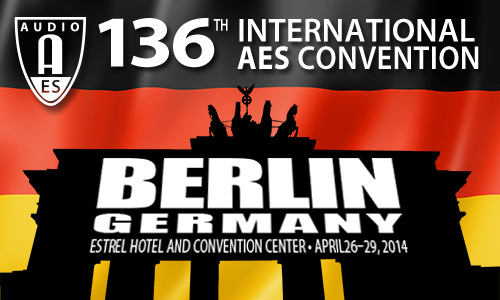AES Berlin 2014
Paper Session P12
P12 - Applications in Audio
Tuesday, April 29, 14:30 — 16:30 (Room Paris)
Chair:
Dylan Menzies, De Montfort University - Leicester, UK
P12-1 A Delayed Parallel Filter Structure with an FIR Part Having Improved Numerical Properties—Balázs Bank, Budapest University of Technology and Economics - Budapest, Hungary; Julius O. Smith, III, Stanford University - Stanford, CA, USA
In real-world applications high-order IIR filters are often converted to series or parallel second-order sections to decrease the negative effects of coefficient truncation and round-off noise. While series biquads are more common, the parallel structure is gaining more interest due to the possibility of full code parallelization. In addition, it is relatively simple to design a filter directly in a parallel form, which can be efficiently utilized for logarithmic frequency resolution filtering often required in audio. If the numerator order of the original transfer function is higher than that of the denominator, a parallel FIR part arises in addition to the second-order IIR sections. Unfortunately, in this case the gain of the sections and that of the FIR filter can be significantly higher than that of the final transfer function, which requires the downscaling of the filter coefficients to avoid overload. This leads to a significant loss of useful bit-depth. This paper analyzes problem and suggests delaying the IIR part so that there is no overlap between the responses of the FIR part and the second-order sections.
Convention Paper 9084 (Purchase now)
P12-2 A Loudness-Based Adaptive Equalization Technique for Subjectively Improved Sound Reproduction—Konstantinos Drossos, Ionian University - Corfu, Greece; Andreas Floros, Ionian University - Corfu, Greece; Nikolaos-Grigorios Kanellopoulos, Ionian University - Corfu, Greece
Sound equalization is a common approach for objectively or subjectively defining the reproduction level at specific frequency bands. It is also well-known that the human auditory system demonstrates an inner process of sound-weighting. Due to this, the perceived loudness changes with the frequency and the user-defined sound reproduction gain, resulting into a deviation of the intended and the perceived equalization scheme as the sound level changes. In this work we introduce a novel equalization approach that takes into account the above perceptual loudness effect in order to achieve subjectively constant equalization. A series of listening tests shows that the proposed equalization technique is an efficient and listener-preferred alternative for both professional and home audio reproduction applications.
Convention Paper 9085 (Purchase now)
P12-3 New Sound and Visual System of the State Parliament of North-Rhine Westphalia in Duesseldorf, Germany—Enno Finder, ADA Acoustics & Media Consultants GmbH - Berlin, Germany; Wolfgang Ahnert, ADA Acoustics & Media Consultants GmbH - Berlin, Germany
In 2012 the assembly hall of the state parliament of North-Rhine Westphalia, located in Duesseldorf, Germany, was renovated extensively. In this context the floor structure has been changed to improve the situation for handicapped delegates and guests. The new sound design have to solve two tasks, namely excellent sound coverage from the lectern and president’s position and sound localization for speeches from a delegate desk by using a kind of a new delta-stereophonic network. The paper will explain all design issues including new microphones on the lectern. The issue to fit the new speaker systems and the new microphone types into the architectural environment is discussed as well the start of renovation of the visual systems.
Convention Paper 9086 (Purchase now)
P12-4 Latest Improvements for Spatial Sound Reinforcement: Configuration’s Automation, Remote Control Using Mobile Devices, and Object Based Room Simulation—Javier Frutos-Bonilla, Fraunhofer Institute for Digital Media Technology IDMT - Ilmenau, Germany; Gabriel Gatzsche, Fraunhofer Institute for Digital Media Technology IDMT - Ilmenau, Germany; Audanika GmbH; Rene Rodigast, Fraunhofer Institute for Digital Media Technology IDMT - Ilmenau, Germany
Fraunhofer IDMT presented in 2005 a sound reinforcement system based on the precedence effect that could recreate the natural spatial impression of static and dynamic sources on the stage regardless of the position of the listeners. Based on the experience learned over the last years, this paper presents three different developments for this system. These improvements are related to the automatic determination of the configuration parameters, the multiuser adjustment of fine parameters on the tribune using portable devices, and a new room simulation approach that takes into consideration both source and listener’s dependencies.
Convention Paper 9087 (Purchase now)
